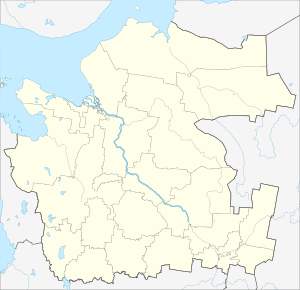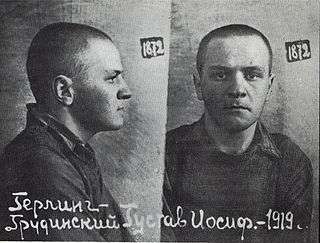Yertsevo
| Yertsevo (English) Ерцево (Russian) | |
|---|---|
|
- Rural locality - Settlement | |
|
| |
.svg.png) Location of Arkhangelsk Oblast in Russia | |
 Yertsevo | |
|
| |
| Administrative status (as of 2012) | |
| Country | Russia |
| Federal subject | Arkhangelsk Oblast |
| Administrative district | Konoshsky District |
| Selsoviet | Yertsevsky Selsoviet |
| Statistics | |
| Population (2010 Census) | 4,201 inhabitants[1] |
| Time zone | MSK (UTC+03:00)[2] |
| Rural locality status since | January 1, 2005[3] |
Yertsevo (Russian: Ерцево) is a rural locality (a settlement) in Konoshsky District of Arkhangelsk Oblast, Russia, located west of Lake Vozhe. Population: 4,201 (2010 Census);[1] 4,013 (2002 Census);[4] 4,683 (1989 Census).[5]
History
Yertsevo was the location of the notorious Soviet concentration camp of the Gulag system before, during, and after World War II.[6] The Yertsevo Camp Complex, one of over a dozen such complexes shared between Arkhangelsk and Vologda Oblasts,[7] was established by the Soviet State Political Directorate secret service already in the 1930s. Since 1940, the camp was managed by the Kargopolsky ITL (Ispravitelno-Trudovoy Lager) directorate.[8] It was located about 3 miles (4.8 km) from the forest where the prisoners cut lumber all day, year-round, usually up to their waist in snow, emaciated, and always hungry.[9]
Witness accounts confirm that the prisoners could survive in the forest-brigade for no more than two years. The dead were buried in mass graves with wooden tags attached to their legs with a string.[10] Only the fresh young arrivals in the Yertsevo camp were put through the forest ordeal. The work productivity norm set by the prison administration was impossible to reach for many of the victims.[9]
Yertsevo was granted urban-type settlement status in 1960, but was demoted to a rural locality on January 1, 2005.[3]
In literature

The Yertsevo labor camp was described in a book entitled A World Apart, written by the eminent Polish writer and philosopher Gustaw Herling-Grudziński, camp survivor and, later, political dissident under the communist system. Captured by the NKVD in early 1940 as a Polish army soldier soon after the Soviet invasion of Poland, Herling-Grudziński spent a year and a half in the Yertsevo camp. Sentenced to five years, but eventually amnestied, he was also imprisoned at the Kargopol labor camp facility.[9]
Prisoners were sent to the bath-house once every month. Some of them self-mutilated themselves at work by cutting off their fingers and rubbing dirt into the wounds in order to be sent to the camp infirmary, the only escape from death by exhaustion.[9] Herling-Grudziński's account of camp life in the Soviet Gulag preceded Solzhenitsyn's revelations by more than a decade.[11][12][13]
Since September 2009 there is a monument to the writer.
See also
References
Notes
- 1 2 Russian Federal State Statistics Service (2011). "Всероссийская перепись населения 2010 года. Том 1" [2010 All-Russian Population Census, vol. 1]. Всероссийская перепись населения 2010 года (2010 All-Russia Population Census) (in Russian). Federal State Statistics Service. Retrieved June 29, 2012.
- ↑ Правительство Российской Федерации. Федеральный закон №107-ФЗ от 3 июня 2011 г. «Об исчислении времени», в ред. Федерального закона №271-ФЗ от 03 июля 2016 г. «О внесении изменений в Федеральный закон "Об исчислении времени"». Вступил в силу по истечении шестидесяти дней после дня официального опубликования (6 августа 2011 г.). Опубликован: "Российская газета", №120, 6 июня 2011 г. (Government of the Russian Federation. Federal Law #107-FZ of June 31, 2011 On Calculating Time, as amended by the Federal Law #271-FZ of July 03, 2016 On Amending Federal Law "On Calculating Time". Effective as of after sixty days following the day of the official publication.).
- 1 2 Resolution #864
- ↑ Russian Federal State Statistics Service (May 21, 2004). "Численность населения России, субъектов Российской Федерации в составе федеральных округов, районов, городских поселений, сельских населённых пунктов – районных центров и сельских населённых пунктов с населением 3 тысячи и более человек" [Population of Russia, Its Federal Districts, Federal Subjects, Districts, Urban Localities, Rural Localities—Administrative Centers, and Rural Localities with Population of Over 3,000] (XLS). Всероссийская перепись населения 2002 года [All-Russia Population Census of 2002] (in Russian). Retrieved August 9, 2014.
- ↑ Demoscope Weekly (1989). "Всесоюзная перепись населения 1989 г. Численность наличного населения союзных и автономных республик, автономных областей и округов, краёв, областей, районов, городских поселений и сёл-райцентров" [All Union Population Census of 1989: Present Population of Union and Autonomous Republics, Autonomous Oblasts and Okrugs, Krais, Oblasts, Districts, Urban Settlements, and Villages Serving as District Administrative Centers]. Всесоюзная перепись населения 1989 года [All-Union Population Census of 1989] (in Russian). Институт демографии Национального исследовательского университета: Высшая школа экономики [Institute of Demography at the National Research University: Higher School of Economics]. Retrieved August 9, 2014.
- ↑ Leona Toker (2000). "Yertsevo". Return from the Archipelago: Narratives of Gulag Survivors. Indiana University Press. p. 255. ISBN 0253337879. Retrieved August 29, 2012.
- ↑ "НИПЦ "Мемориал", при содействии фонда Фельтринелли и кафедры картографии географического факультета МГУ". Карта ГУЛАГа (Gulag map). The Memorial Society, Russia. Retrieved August 29, 2012.
- ↑ "Yertsevo (Ерцево)". GPS Places and POI in Russia (in Russian and English). Geo Deg beta. 2011. Retrieved August 29, 2012.
- 1 2 3 4 George Mason University (2008–2012). "Labor". Days and Lives :: Prisoners. Rosenzweig Center for History. Retrieved August 29, 2012.
- ↑ Robert Conquest. "The Red Holocaust". The Great Terror. Genocides Museum. Retrieved August 29, 2012.
- ↑ Anne Applebaum (2012), "Anne Applebaum on Memoirs of Communism", FiveBooks Interviews, The Browser - Writing Worth Reading,
A World Apart by Herling-Grudziński is... one of the two or three best Gulag memoirs. And one of the first too – it came out 10 years before Solzhenitsyn's A Day in the Life of Ivan Denisovich. — Source link: thebrowser.com/interviews/anne-applebaum-on-memoirs-communism?page=2
- ↑ Leszek Strzelecki, Beltsville, MD United States (February 2, 2005). "A masterpiece yet to be discovered". Review: A World Apart: Imprisonment in a Soviet Labor Camp During World War II by Gustaw Herling-Grudziński. Amazon.com. Retrieved August 30, 2012.
- ↑ From the Publisher (2005). A World Apart. Penguin Books. ISBN 0141187956. Retrieved September 17, 2012.
Sources
- Архангельское областное Собрание депутатов. Постановление №864 от 10 сентября 2004 г. «О преобразовании рабочего посёлка Ерцево Коношского района Архангельской области». Вступил в силу 1 января 2005 г. Опубликован: "Волна", №36, 24 сентября 2004 г. (Arkhangelsk Oblast Assembly of Deputies. Resolution #864 of September 10, 2004 On the Transformation of the Work Settlement of Yertsevo in Konoshsky District of Arkhangelsk Oblast. Effective as of January 1, 2005.).